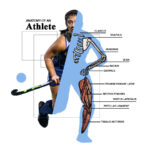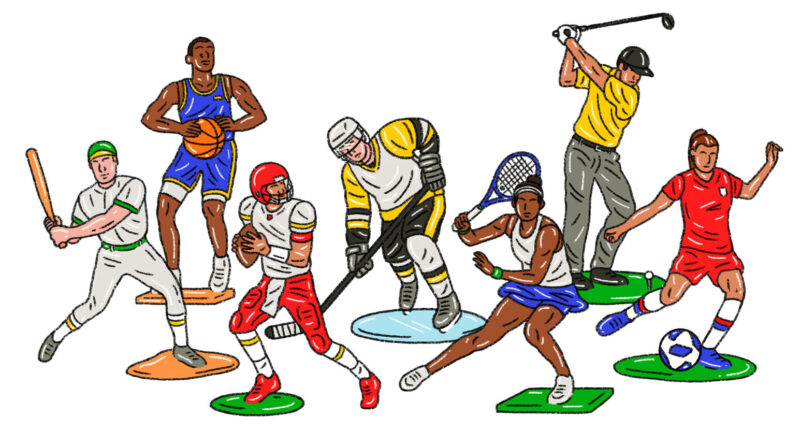Student Athletes Health Education
Beyond their experiences in the classroom, student-athletes at Ithaca College are expanding their knowledge of the human body through the grind of practice sessions and the excitement of game days. Student Athletes Health Education.
During the 2022–23 academic year, out of the 286 total student-athletes that were elected to the Liberty League All-Academic team, 118 of them were members of the School of Health Sciences and Human Performance. There are 214 student-athletes studying within HSHP, which makes up about 31% of the school’s enrollment.
Junior Juliana Valli, a striker on the field hockey team, is a physical therapy major and art minor. Growing up playing field hockey, Valli said she discovered the college through its strong athletic programs on the field and in the classroom.
After working at Synergy Physical Therapy — a sports clinic in Hackettstown, New Jersey — since her junior year of high school, Valli said she was able to see how hands-on and connection-based sports medicine was and instantly fell in love. Valli said she knew that sports medicine was for her, but she feared that pursuing the major would stifle her love for art.
Art Translates to Health Science
“I’ve always loved fashion, I’ve always loved sewing, I’ve always loved doing stuff with my hands,” Valli said. “I felt like I had two aspects of myself, like two different personas: my creative side and my athletic side. I had to really think about what my strengths and weaknesses are and I had to really think of what I wanted as a career.”
After exploring the college’s art minor, Valli said her love for the field was amplified and even translated into her work in health sciences.
“Even with art, if I decide to work in [health sciences], I know bringing in a creative aspect, like art therapy, would make the experience better for the people I’m connecting with,” Valli said.
Valli is not alone in her journey studying physical therapy. Of the field hockey team’s 27-woman roster, 13 of the athletes are studying health-related fields, including occupational therapy, athletic training and clinical health studies.
Tackling such a science-based field like physical therapy can be intimidating, but Valli said having her own experience as an athlete has helped her knowledge from the classroom translate onto the field.
“The other day my knee was hurting me and to realize that I needed to stretch a certain muscle in my quad was crazy to me,” Valli said. “To be able to figure that out and to say, ‘Wow, we talked about that in class the other day. I know this now and I can help myself out,’ is awesome.”
Training and Recovery
Kaitlyn Wahila, head coach of the field hockey team, said the volume of health science students on the team contributes greatly to the team’s overall mindset regarding its training program and recovery techniques.
“I do think that our health science student-athletes overall, because they’re studying it all the time, definitely know how important that process of strength training, conditioning and recovery is,” Wahila said.
Sophomore Cullen Adams — an exercise science and pre-athletic training major and midfielder on the men’s lacrosse team — said he chose to travel from Portland, Maine to upstate New York specifically for the college’s health science programs, but is also excited to continue playing the sport he loves.
Growing up, Adams said his mom would always tell him that he was good at making others feel better and he always felt great sympathy when seeing his teammates or even opposing players get injured on the field.
“After seeing someone get injured, you just feel so bad because you know they’re struggling with the notion that they won’t be able to play for a while,” Adams said.
Sports Setting Working in Health Scinece
Despite his original intent to go into nursing, Adams said his experience as an athlete drew him back to the playing field. After hearing stories from his grandfather, a collegiate sports doctor at the University of Maine, Adams said he knew wanted to go into sports medicine.
“I liked health and science in high school and I was originally thinking about doing nursing, but working in a hospital didn’t really appeal to me,” Adams said. “Then I learned about athletic training which would allow me to be in a sports setting while still working with health and science. It really excites me that my job will allow me to work in a nontraditional setting and be around sports.”
With graduate programs in exercise science, physical therapy and physician assistant studies — among others — many HSHP students at the college go on to pursue careers in athletic training, performance coaching and sports medicine.
During the Spring 2023 semester, Adams shadowed the athletic trainers for the college’s women’s lacrosse team. Adams said that a few times each week, he would go to the clinic at the Athletics and Events Center to observe how the trainers would perform different kinds of treatment before and during the team’s practices.
Atmosphere and Interaction
Adams said getting to witness the atmosphere of the clinic and how the trainers interacted with the athletes on the field further solidified his desire to pursue a career working in sports medicine.
“I couldn’t do anything hands-on on the sideline to help, but seeing how the trainers communicated and worked was definitely a good experience for me,” Adams said. “I really enjoyed the whole experience as for the first time it felt like I was getting real experience in the field that I want to have a career in.”
Tim Reynolds ’14, assistant professor in the Department of Exercise Science and Athletic Training, was a baseball player while he was a student at the college. Reynolds said he values having that experience because he knows how hard student-athletes work to do their best on the field and in the classroom.
“I make an announcement at the beginning of the semester and ask how many student-athletes we have and I tell them that I was a student-athlete too,” Reynolds said. “I understand that it is a very demanding program and that their career paths will be very demanding, but it’s a very selfless career path, you will have the opportunity to give and to help others. You’re in a service industry and you are trying to help people physically and mentally, so it’s important that I know the physical and mental demands that they are going through.”
Edge in the Field
“They’ve been practicing it on the field and they finally get a chance to really see how the human body works and learn about it,” Reynolds said. “Seeing the lightbulb effect when they finally learn the names of the muscles in the body and figure out the different bones and joints in the body is something I really appreciate because they get to learn about their own craft and learn the academic side of it all.”
Source: Student Athletes Health Education
https://www.techedmagazine.com/category/news-by-industry/health-sciences/
https://www.ithaca.edu/academics/school-health-sciences-and-human-performance


